商务英语口试常见话题
- 格式:doc
- 大小:58.50 KB
- 文档页数:10

商务英语口语01、商务场景下1.what time would be convenient for you?你看什么时间比较方便?2.I'd like to suggest a toast to our cooperation.我想建议为我们的合作干一杯。
3.Here is to our next project!为我们下一个项目干杯!4.Would you please tell me when you are free?请问你什么时候有空?5.Glad to have the opportunity of visting your ompany andI hope to conclude some business with you。
很高兴能有机会拜访贵公司,希望能与你们做成交易。
6.what I care about is the quality of the goods.我关心的是货物的质量。
7.please have a look at those samples.请给我看一下那些样品。
8.I'd like to know any business connections abroad.我想多了解一些你们公司。
9.I would be happy to supply samples and a price list for you.我很乐意提供样品和价格单给你。
10.can I have your price list?你能给我价格单吗?11.will you give us an indication of prices?你可以给我报一个指示性的价格吗?12.I am in charge of export business.我负责出口生意。
13.I'm thinking of ordering some of your goods.我正考虑向你们订货。
14.what about the prices?那价格方面怎么样?15.Let's call it a deal.好,成交!16.our product is the best seller.我们的产品最畅销。
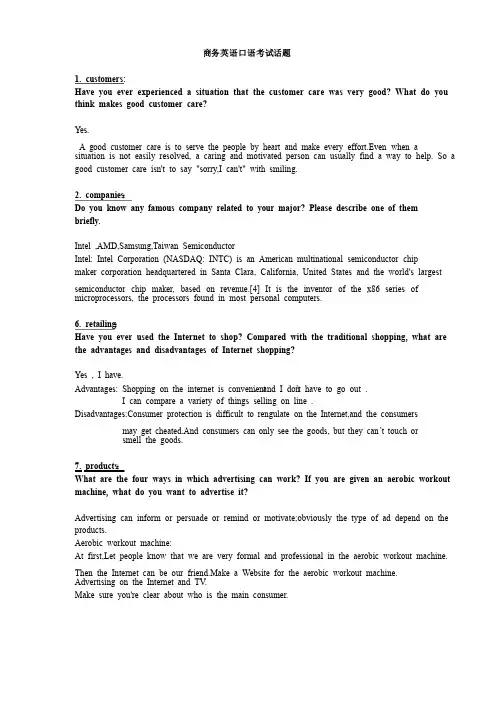
商务英语口语考试话题1. customers: Have you ever experienced a situation that the customer care was very good? What do you think makes good customer care? Yes. A A good good good customer customer customer care care care is is is to to to serve serve serve the the the people people people by by by heart heart heart and and and make make make every every every effort.Even effort.Even effort.Even when when when a a situation is not easily resolved, a caring and motivated person can usually find a way to help. So a good customer care isn't to say "sorry,I can't" with smiling. 2. companies :Do Do you you you know know know any any any famous famous famous company company company related related related to to to your your your major? major? major? Please Please Please describe describe describe one one one of of of them them briefly. Intel ,AMD,Samsung,Taiwan Semiconductor Intel: Intel: Intel Intel Intel Corporation Corporation Corporation (NASDAQ: (NASDAQ: (NASDAQ: INTC) INTC) INTC) is is is an an an American American American multinational multinational multinational semiconductor semiconductor semiconductor chip chip maker corporation headquartered in Santa Clara, California, United States and the world's largest semiconductor chip maker, based on revenue.[4] It is the inventor of the x86 series of microprocessors, the processors found in most personal computers. 6. retailing :Have you ever used the Internet to shop? Compared with the traditional shopping, what are the advantages and disadvantages of Internet shopping? Yes , I have. Advantages: Shopping on the internet is convenient ,and I don’t have to go out . I can compare a variety of things selling on line . Disadvantages:Consumer Disadvantages:Consumer protection protection protection is is is difficult difficult difficult to to to rengulate rengulate rengulate on on on the the the Internet,and Internet,and Internet,and the the the consumers consumers may may get get get cheated.And cheated.And cheated.And consumers consumers consumers can can can only only only see see see the the the goods, goods, goods, but but but they they they can can can’’t t touch touch touch or or smell the goods. 7. products :What are the four ways in which advertising can work? If you are given an aerobic workout machine, what do you want to advertise it? Advertising can inform or persuade or remind or motivate;obviously the type of ad depend on the products. Aerobic workout machine: At first,Let people know that we are very formal and professional in the aerobic workout machine. Then the Internet can be our friend.Make a Website for the aerobic workout machine. Advertising on the Internet and TV . Make sure you're clear about who is the main consumer. 8. people What are the differences between men and women in the workplace? Whom do you think is easier to work with, men or women? Why? Men tend to be competitive ,while women method is collaborative. Men often think of the heart of the problems ,while women always look at various options. Men ’s body language include forceful gestures while women not. It is hard to say who is easier to work with.Generally speaking, women tend to be more emotional. Men are physically stronger than women. If I must make a choice,I think men is easier to work. with. So I can say and behave myself ,not worry about the jealousy. 9. business environment :Many everyday brands used by people can have varying prices throughout the world. What do do you think you think are the possible factors which can influence price? Take a factor a s example, as example, and say why it can influence price. Possible factors:Some of the variations in price are due to differences in exchange rates,some are due to the differences in local raw materials and production or shopping costs and some are due to variation in taxes and the oil price. Oil Oil price:.For price:.For price:.For example,the example,the example,the cost cost cost of of of the the the increasing increasing increasing oil oil oil price price price is is is natural natural natural increase increase increase in in in transportation transportation fee.The increase cost of transportation can lead to higher price of every brands. 12. competition :What are the three strategies which are very important for a company to become a market leader? If your company wants to launch a new product “Lucky Cola ”, what do you want to do to make your product more competitive? Cost :so reducing cost,producing more cheaply ,selling more cheaply Differetiation :that is making your pruducts appear very special in the market place Innovation Innovation :so :so :so finding finding finding new new new products products products and and and new new new ways ways ways to to to market market market products,which products,which products,which is is is particularly particularly important in the global market. Job interview: What would you like to do after you finish your studies? (Why?) l go abroad, look for a job, hunt for a job, study further, post graduate What are you doing now for the preparation of your future plan? l knowledge preparation: attend training course l psychological preparation: be mature l improve interpersonal skills 。
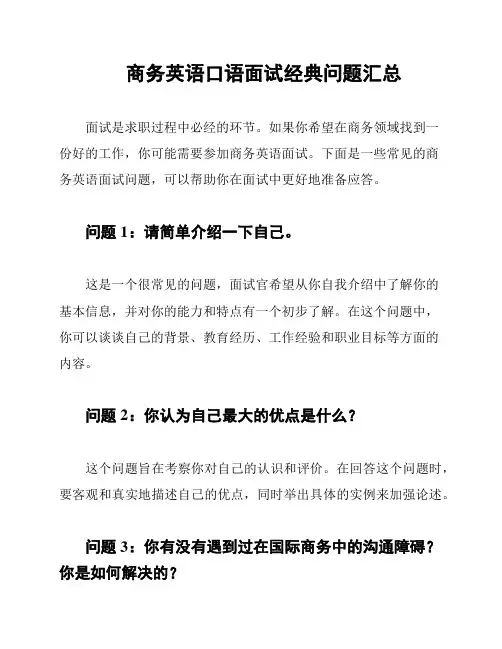
商务英语口语面试经典问题汇总
面试是求职过程中必经的环节。
如果你希望在商务领域找到一
份好的工作,你可能需要参加商务英语面试。
下面是一些常见的商
务英语面试问题,可以帮助你在面试中更好地准备应答。
问题1:请简单介绍一下自己。
这是一个很常见的问题,面试官希望从你自我介绍中了解你的
基本信息,并对你的能力和特点有一个初步了解。
在这个问题中,
你可以谈谈自己的背景、教育经历、工作经验和职业目标等方面的
内容。
问题2:你认为自己最大的优点是什么?
这个问题旨在考察你对自己的认识和评价。
在回答这个问题时,要客观和真实地描述自己的优点,同时举出具体的实例来加强论述。
问题3:你有没有遇到过在国际商务中的沟通障碍?你是如何解决的?
由于商务交流中可能涉及不同的文化、语言等因素,所以这个问题非常重要。
面试官想要了解你在沟通过程中是否有解决问题的策略和方法。
问题4:你是如何管理并处理工作压力的?
商务工作中通常存在一定的压力,因此面试官希望知道你是否能够应对这样的挑战。
在回答这个问题时,可以举出具体的工作例子,讲述自己是如何面对困难、调整心态以及保持工作效率的。
问题5:你认为什么样的企业文化最适合你?
面试官想要了解你的价值观和对企业文化的理解。
这个问题需要你对不同的企业文化进行调研和了解,找到最符合自己个性和能力的企业文化,并提供具体的分析和阐述。
这些是商务英语面试中常见的问题,做好充分的准备,清晰地回答这些问题,可以帮助你赢得这场面试的成功。
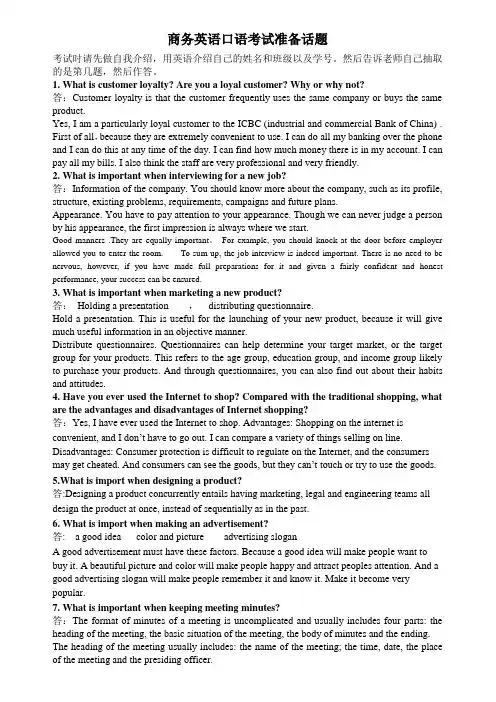
商务英语口语考试准备话题考试时请先做自我介绍,用英语介绍自己的姓名和班级以及学号。
然后告诉老师自己抽取的是第几题,然后作答。
1. What is customer loyalty? Are you a loyal customer? Why or why not?答:Customer loyalty is that the customer frequently uses the same company or buys the same product.Yes, I am a particularly loyal customer to the ICBC (industrial and commercial Bank of China) . First of all,because they are extremely convenient to use. I can do all my banking over the phone and I can do this at any time of the day. I can find how much money there is in my account. I can pay all my bills. I also think the staff are very professional and very friendly.2. What is important when interviewing for a new job?答:Information of the company. You should know more about the company, such as its profile, structure, existing problems, requirements, campaigns and future plans.Appearance. You have to pay attention to your appearance. Though we can never judge a person by his appearance, the first impression is always where we start.Good manners .They are equally important。
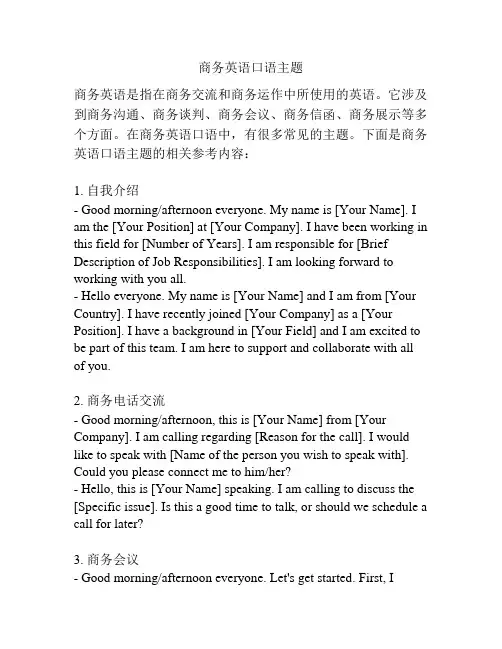
商务英语口语主题商务英语是指在商务交流和商务运作中所使用的英语。
它涉及到商务沟通、商务谈判、商务会议、商务信函、商务展示等多个方面。
在商务英语口语中,有很多常见的主题。
下面是商务英语口语主题的相关参考内容:1. 自我介绍- Good morning/afternoon everyone. My name is [Your Name]. I am the [Your Position] at [Your Company]. I have been working in this field for [Number of Years]. I am responsible for [Brief Description of Job Responsibilities]. I am looking forward to working with you all.- Hello everyone. My name is [Your Name] and I am from [Your Country]. I have recently joined [Your Company] as a [Your Position]. I have a background in [Your Field] and I am excited to be part of this team. I am here to support and collaborate with all of you.2. 商务电话交流- Good morning/afternoon, this is [Your Name] from [Your Company]. I am calling regarding [Reason for the call]. I would like to speak with [Name of the person you wish to speak with]. Could you please connect me to him/her?- Hello, this is [Your Name] speaking. I am calling to discuss the [Specific issue]. Is this a good time to talk, or should we schedule a call for later?3. 商务会议- Good morning/afternoon everyone. Let's get started. First, Iwould like to briefly go over the agenda for today's meeting. We will be discussing [Topic 1], [Topic 2], and [Topic 3]. I encourage everyone to actively participate and share their ideas.- Thank you all for attending today's meeting. I would like to start by giving a brief update on [Project/Task]. Then, I will open the floor to any questions or concerns you may have.4. 商务谈判- We are looking for a win-win situation in this negotiation. Both parties should benefit from the final agreement. Let's explore options and find a solution that meets our mutual needs.- It seems like we have reached an impasse. Is there any room for compromise? Let's brainstorm together and find a middle ground that satisfies both parties.5. 商务信函- Dear [Recipient's Name], I am writing to inquire about [Specific Information]. Could you please provide me with the details? Thank you in advance for your assistance.- Dear [Recipient's Name], I am writing to follow up on our previous discussion regarding [Project/Task]. I would like to request an update on the progress. Please let me know if there is anything I can do to support the team.6. 商务展示- Good morning/afternoon everyone. Thank you for joining me today. I will be presenting on [Topic]. First, I will provide a brief overview of the subject, followed by the key findings. If you have any questions, feel free to interrupt me at any time.- As you can see from the slide, the data shows a significantincrease in sales. This can be attributed to our new marketing strategy. Moving forward, we plan to further capitalize on this success and expand our market share.以上是商务英语口语主题的相关参考内容。
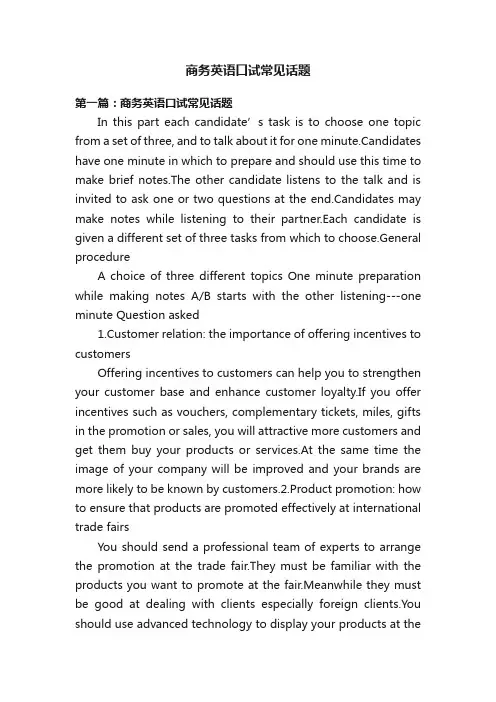
商务英语口试常见话题第一篇:商务英语口试常见话题In this part each candidate’s task is to choose one topic from a set of three, and to talk about it for one minute.Candidates have one minute in which to prepare and should use this time to make brief notes.The other candidate listens to the talk and is invited to ask one or two questions at the end.Candidates may make notes while listening to their partner.Each candidate is given a different set of three tasks from which to choose.General procedureA choice of three different topics One minute preparation while making notes A/B starts with the other listening---one minute Question asked1.Customer relation: the importance of offering incentives to customersOffering incentives to customers can help you to strengthen your customer base and enhance customer loyalty.If you offer incentives such as vouchers, complementary tickets, miles, gifts in the promotion or sales, you will attractive more customers and get them buy your products or services.At the same time the image of your company will be improved and your brands are more likely to be known by customers.2.Product promotion: how to ensure that products are promoted effectively at international trade fairsYou should send a professional team of experts to arrange the promotion at the trade fair.They must be familiar with the products you want to promote at the fair.Meanwhile they must be good at dealing with clients especially foreign clients.You should use advanced technology to display your products at thefair.Necessary equipments such as DVD, overhead projector, high-definition screen can help you demonstrate the quality, function and specification of your products.You should design your show room and stand carefully to attract more customers.Your stand should be put up at an obvious place so that every customer can get an easy access to your products.3.How to reduce labor turnover ratesIn order to reduce labor turnover rates we must take the following effective measures: Set up a clear staff appraisal process to make sure that the performance of every staff can be evaluated openly and honestly and their promotion is based on their contribution to the company.Thus no one will complaint about unfair promotion which once forced some of your staff to leave their jobs.If permits enhance the staff benefits including their base pay annual bonus and other benefits.An incentive system should also be necessary to encourage the staff to work with the company longer.Improve the work environment of your company or factory.Try to foster a spirit of mutual help among your staff and let them understand that the company or factory is far more than just a workplace.It’s a family where all members are supported and valued.4.Career development: the importance of being willing to acquire new skills throughout your career With the unceasing development of science and technology the workplace is now undertaking profound changes.The way you do your work and the equipment you use in your work will definitely change or upgrade in the future, which means you have to learn new skills to deal with these changes.Remember: you are never too old to learn.New skills will make you keep up with the latest technology and help develop yourself throughout your work life.5.International sales: how to research foreign marketseffectivelyYou should notice the difference between foreign and domestic market and set your target according to specific situation of foreign market.For example: given the different state of living standard the purchasing power of your target market may be higher or lower than the domestic market.If you ignore the difference you are likely to make mistakes in products’ pricing in foreign market.You should ensure that your research team is excellent at carrying out research in a foreign country.That means every member of the team should mater the native language and be familiar with the specific culture of the target market.6.Production management: how to implement an effective just-in-time system What is a JIT production system? JIT is an approach to achieving excellence in a manufacturing company based on the continuing elimination of waste(waste being considered as those things that do not add value to the product).A repetitive production system in which both the movement of goods during production, and deliveries from suppliers, are carefully timed so that at each step of the process, the next(usually small)batch arrives for processing just as needed.The logic behind JIT: Nothing will be produced until it is needed.7.Travel: the importance of being able to speak foreign languages in international business8.Marketing: how to assess whether there is a market for a new productYou should carry out a research on the customer demands to see if there is a read need in the market for your new product.The feedback or result will help you to decide whether to launch the new product on the market.You should pay special attention to your competitors.Detect whether they are going to launch theirnew product onto the market.if the answer if yes that probably means there is a demand in the market for some new product.Then be quick and put on your rival product to coincide with them.9.Human resources: how to use staff appraisal schemesYou should see to it that the staff appraisal schemes be a chance for management and employees to come together and exchange ideas, set joint targets and improve the way decisions are reached.The scheme should have a clear appeal process and any negative feedback should be accompanied by evidence such as dates, times and outcomes.Most importantly ratings should reflect measurable element of the job requirements.10.Advertising: the importance of television and cinema advertisementIn fact television and cinema advertising both function as a kind of media which tells or even guides people to buy products or services.With the development of the telecommunication television has become the most important carrier of advertisement and as a result of that TV advertising has the largest amount of audience all over the world.They have penetrated into people’s daily life and persuaded them to buy whenever they turn on them.On the other hand the popularity of the movie make every audience be under the influence of cinema advertising at the beginning and end of the movie.11.Staff management: how to ensure effective lines of communication between the workforce and managementAs the leader of the company you should open up a channel for the workforce and management to communicate directly.For example you can hold a monthly meeting within the company, which is attended by both the reps from workforce andmanagement.They are allowed to talk with each other openly and freely to exchange views and opinions.They can also set common objectives.You should achieve this effectiveness by making use of up-to-date technologies.For example you can set up a forum on the intranet of your company so that every member can air and exchange their views on the forum.In this way a effective line of communication will be set up.You should set up an incentive system to make your staff talk with their line managers.12.Finance: how to ensure accurate cashflow forecasts you should establish a monitor system in the first place to detect any possible cashflow gap which will occur during your production and operation.This system can calculate the balance between your income and expenditure on a daily base.And should there be any sign of cashflow problems the system will warn your staff to do something about it before hand.In order to achieve the accuracy you must set up a report system which demands every manager report the current financial status of his or her departments.The information will be collected everyday for you to take consideration.13.International sales: how to decide which sales incentives to offer a new foreign customer(本题做为思考题,请大家自行考虑一下。
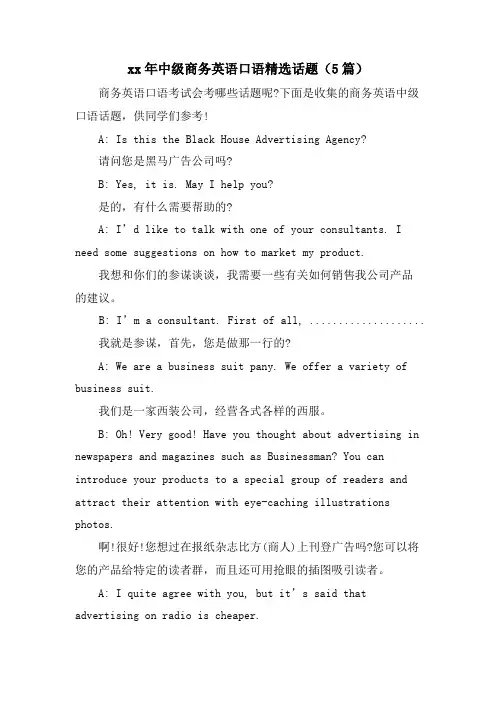
xx年中级商务英语口语精选话题(5篇)商务英语口语考试会考哪些话题呢?下面是收集的商务英语中级口语话题,供同学们参考!A: Is this the Black House Advertising Agency?请问您是黑马广告公司吗?B: Yes, it is. May I help you?是的,有什么需要帮助的?A: I’d like to talk with one of your consultants. I need some suggestions on how to market my product.我想和你们的参谋谈谈,我需要一些有关如何销售我公司产品的建议。
B: I’m a consultant. First of all, ....................我就是参谋,首先,您是做那一行的?A: We are a business suit pany. We offer a variety of business suit.我们是一家西装公司,经营各式各样的西服。
B: Oh! Very good! Have you thought about advertising in newspapers and magazines such as Businessman? You can introduce your products to a special group of readers and attract their attention with eye-caching illustrations photos.啊!很好!您想过在报纸杂志比方(商人)上刊登广告吗?您可以将您的产品给特定的读者群,而且还可用抢眼的插图吸引读者。
A: I quite agree with you, but it’s said that advertising on radio is cheaper.我非常同意您的观点,但据说在广B: I see what you mean. But on one hand, we cannot advertise very long on radio because it is expensive. Timeis very limited. On the other hand, people seldom listen to the radio now. Only very established, well-known panies can suessfully advertise through radio.A: And what about television mercials?B: As we all know, of all the advertising media, TV is the most expensive but it attracts a large number ofviewers because bines sound, movement and color togetherand people can see the real thing.A: I see. Maybe I should advertise our products in survey shows that people tend to rely more on personal sources for information on advanced products such as puters, and more on magazines for information ordinary productssuch as clothing and so on.B: That makes sense. You are certainly targetingspecific customers such as businessmen.A: Hello. Is this the ABC Company?您好!这里是 ABC 公司吗?B: Good morning .Yes, this is ABC Company. May I help you ?早上好!是的!这里是 ABC 公司,请问您有什么事?A: My name is Liufang from M%26amp;H Company. I would like to speak with someone who is responsible for imports.我是 M%26amp;H 公司的刘放。
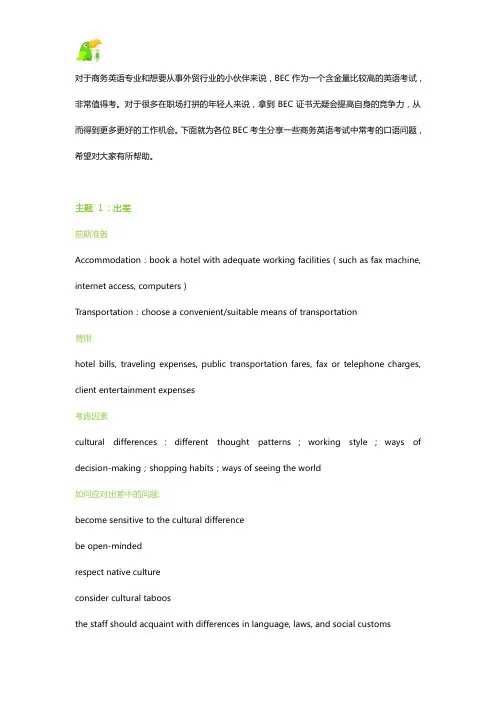
对于商务英语专业和想要从事外贸行业的小伙伴来说,BEC作为一个含金量比较高的英语考试,非常值得考。
对于很多在职场打拼的年轻人来说,拿到BEC证书无疑会提高自身的竞争力,从而得到更多更好的工作机会。
下面就为各位BEC考生分享一些商务英语考试中常考的口语问题,希望对大家有所帮助。
主题1:出差前期准备Accommodation:book a hotel with adequate working facilities(such as fax machine, internet access, computers)Transportation:choose a convenient/suitable means of transportation费用hotel bills, traveling expenses, public transportation fares, fax or telephone charges, client entertainment expenses考虑因素cultural differences:different thought patterns;working style;ways of decision-making;shopping habits;ways of seeing the world如何应对出差中的问题:become sensitive to the cultural differencebe open-mindedrespect native cultureconsider cultural taboosthe staff should acquaint with differences in language, laws, and social customsrelocate the employee to work abroad to experience different working style•主题2:员工培训培训内容+ 培训带来的好处communication skills +avoid misunderstanding;get the work well donecustomer service +it is critical to meet customers' needs;increase customers' satisfactioninterpersonal relationship + enhance mutual understanding and trustcomputer skills + it is important for conducting administrative and offer taskssafety training + give practical advice for avoiding getting hurtbusiness ethics +customers’loyalty and trust to the company重要性从公司发展的角度看:enhance company imageincrease productivity从雇员的角度:increase job satisfactionboost morale(among employees)enhance efficiencies in process which result in financial gainreduce employee turnover/retain employeeacquire more practical skills that is beneficial for the personal developmentensure employees have greater commitment in their work/continue effortensure employees keep up with the latest information for market trendhelp them have a clear idea of future job如何使培训有成效Good preparation ensures effective trainingmaintain a positive energy and attitudefully equipped facilitiesmeet the training needs/requirementscompany budgetwell-organized materials如何鉴定培训是否具有成效organize a relevant test to conduct a survey to participants to see whether they have any improvement in the work performancewhether the training address the issues/solve problems主题3:激励员工留住员工措施:(具体措施+好处)offer financial benefits/bonuseffective trainingprovide cozy/comfortable working environment + feel at ease/increase efficiency paid holidayprofit-sharing planstock optionconstant communication between the employer and the employerflexible working hour+ balance work and life/reserve time for family, hobby or personal developmentoffer some special gift that meet employees' expectationopportunities for promotionoffer physical health check-up for the staff/membership or discount at health and fitness club主题4:招聘Recruiting内部招聘internal promotion优点:have more motivational valueencourage employees to continue effortgive other employees anticipation of promotionreduce the orientation and training costmake good use of abundant human resources缺点:if not fair,it will lead to internal conflict内部招聘的具体做法:a selection test/well-designed interview/check record of past performance/appraisal外部招聘external recruitment优点:receive a source of new ideas/latest knowledgeavoid unfair selectingbe contributable to company's overall growth and success缺点:discourage moraleincrease training cost主题5:广告宣传方式各种方式的优缺点:优+缺(同广告不同宣传方式的优缺点)Internet(online recruitment):lost cost;reach vast audience/attract wide attention;attract potential customers + may be annoyingTelevision:reach vast audience + high cost;people often change channels Newspaper(put ad in the local newspaper):reach vast reader + life span is short, readers often discard them quicklyask a recruitment company :professional + high cost;cannot find the right person radio:low costgive out free sample:give a personal experiencesend direct email to target customers:get a mailing list of target customers;attract potential customers + people often ignore or just delete it immediately without open (should use attractive headline)give out leaflets主题6:商务会议agenda (key point):set out in advance to state date, time and location;inform them of all the items to be discussed together;ask them for suggestions for items venue:choose a suitable venue;with convenient transportation;big enough to accommodate all the participants;facilities:fully equipped with necessary facilities such as overhead projector, fax, telephone, computer with access to the internetthe size/length of the meeting集会的目的:keep on track of market trendgather ideas to reach more workable final decisionoffer platform to share valuable experienceexchange views to solve problem.其他形式的集会活动buffet dinnersafternoon teatimesightseeing toura reward ceremony参会需要带的文件work plansanalysis for market trend and developmentsales reportrelated figures/data give a overall pictureuseful for setting goals/targets参加会议需要注意什么(会中):listen carefully :show respect to others;benefit from their viewstake notes:ensure not miss the important items;useful for later reference主题7:缓解工作压力/应对繁重工作表现consistently working lateworking through lunchcome to work even when ill/often ask for sick leaverush to meet tight deadlinebring work home后果high turnoverpoor performancein low spiritlower productivity应对措施time management training: prioritize all tasks in order of importance and urgency +feel at ease with their routine workflexible working time + balance work and lifeprovide some sports facilities/organize sports activities + enhance employees’health encourage to take up a hobby + get off the fatigueprovide coffee rooms and nutritious refreshment + help to relaxprovide childcare/elder care/transportation facilities + help to cope with these responsibilities主题8:解决公司危机的措施issue a news release make arrangement for the victimsoffer all kinds of assistanceoffer some compensationassign some staff to their family to help to cope with tragedyorganize some related training programrecall all the product from the market to prevent possible danger主题9:公司选址/迁址考虑因素:get closer to the target marketcheaper labor cost;low rates of corporate taxconvenient public transportationavoid competitionconsider expansion potentialbetter working environment :boost business;lead to higher-quality performance;increase company's profits主题10:市场营销(产品相关的话题)产品属性:brand;price;quality;after-sales service;reputation;reliability价格的制定影响因素:competition; supply and demand; customers ‘perception of price措施:offer seasonal /trade/cash discount to stimulate demand, boost sale ;carry out survey to find out customers' needs and tastes产品推销/推广目的aim at target market;promote product efficiency;meet and beat fierce competition capture a large market share方式launch an advertising campaignpersonal selling:employ some experienced salespeoplesales promotion:offer promotional gifts;coupons 优惠券;rebate 回扣;loyalty scheme;sweepstake 抽奖;free samples;trading stamp;contest publicity:mass media好处attract potential customersboost the sale of productencourage customers to try new products客户服务目的increase the level of customer satisfaction;meet customers' expectation;improve the standard of customer service提高服务质量的措施:have an after-sale services supervision systemstaff training program (improve staff friendliness;the speed of service;learn to deal with customer complaints)check sales figures regularlyobtain feedback from customer (set up a hotline;conduct a survey)留住顾客understand what the customer needsprovide high quality product and good serviceoffer some discount to regular customerupgrade interior decoration主题11:招待客户招待方式+具体目的arrange a big welcoming dinner+ show warm welcome/hospitality;make them feel at ease;set a stage for conversation and potential businessshow them around our company, especially the best part + give them an overview of our facilities and production methodstake them to see places of cultural and historical interest/experience cultural events + offer us good opportunities to get to know each other better;give them more insight into our way of doing business;help encourage their business interest inchina;have a chance to take in the local flavor以上就是英语趣配音为各位BEC考试分享的常考口语话题。
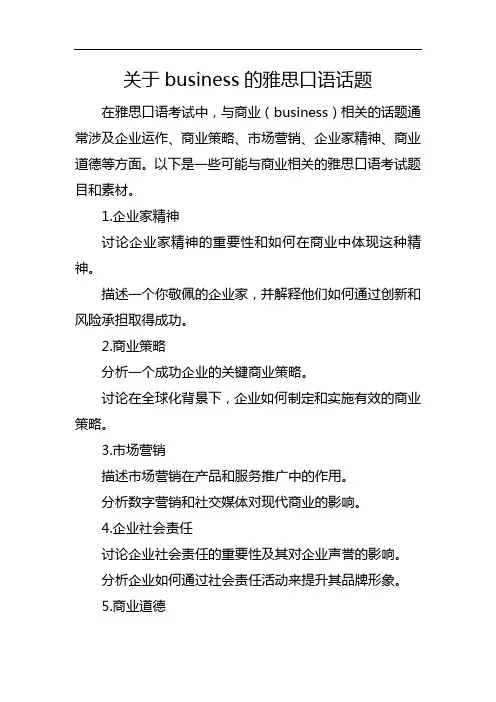
关于business的雅思口语话题在雅思口语考试中,与商业(business)相关的话题通常涉及企业运作、商业策略、市场营销、企业家精神、商业道德等方面。
以下是一些可能与商业相关的雅思口语考试题目和素材。
1.企业家精神讨论企业家精神的重要性和如何在商业中体现这种精神。
描述一个你敬佩的企业家,并解释他们如何通过创新和风险承担取得成功。
2.商业策略分析一个成功企业的关键商业策略。
讨论在全球化背景下,企业如何制定和实施有效的商业策略。
3.市场营销描述市场营销在产品和服务推广中的作用。
分析数字营销和社交媒体对现代商业的影响。
4.企业社会责任讨论企业社会责任的重要性及其对企业声誉的影响。
分析企业如何通过社会责任活动来提升其品牌形象。
5.商业道德解释商业道德的重要性以及如何在商业决策中体现道德原则。
讨论商业道德争议案例,如企业不当行为、数据隐私泄露等。
6.创业经历分享你或你认识的人的创业经历。
描述创业过程中遇到的挑战和如何克服这些挑战。
7.商业创新分析商业创新如何推动企业发展和经济增长。
描述一个你熟悉的创新商业模式或产品。
8.商业环境讨论商业环境的变化以及企业如何适应这些变化。
分析全球经济趋势对商业活动的影响。
准备这些商业话题时,考生可以从以下几个方面收集素材和构思回答:个人经验:分享自己在商业活动或项目中的经历。
当地案例:引用本地区或国家的商业成功案例或挑战。
全球视角:讨论全球性的商业趋势和其对各国的影响。
专业知识:结合商业管理、市场营销等相关领域的知识。
数据和统计:使用可靠的数据和统计来支持观点。
通过结合实际例子、个人观察和专业知识,考生可以更好地回答这些商业话题,并在雅思口语考试中展现出自己的商业意识和分析能力。
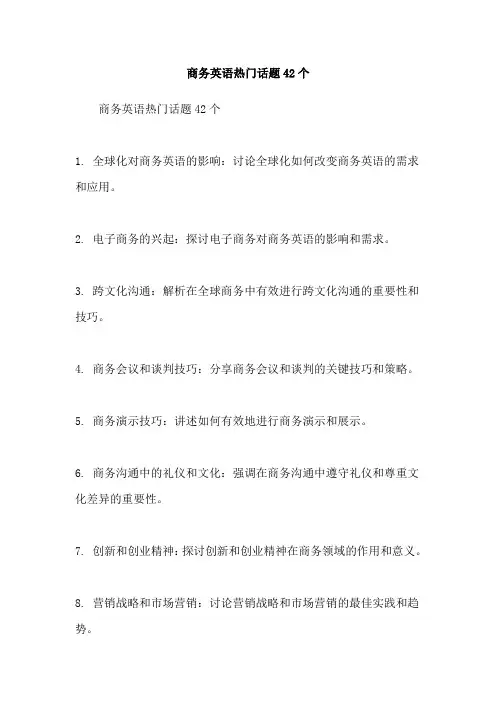
商务英语热门话题42个商务英语热门话题42个1. 全球化对商务英语的影响:讨论全球化如何改变商务英语的需求和应用。
2. 电子商务的兴起:探讨电子商务对商务英语的影响和需求。
3. 跨文化沟通:解析在全球商务中有效进行跨文化沟通的重要性和技巧。
4. 商务会议和谈判技巧:分享商务会议和谈判的关键技巧和策略。
5. 商务演示技巧:讲述如何有效地进行商务演示和展示。
6. 商务沟通中的礼仪和文化:强调在商务沟通中遵守礼仪和尊重文化差异的重要性。
7. 创新和创业精神:探讨创新和创业精神在商务领域的作用和意义。
8. 营销战略和市场营销:讨论营销战略和市场营销的最佳实践和趋势。
9. 团队合作和领导力:分享团队合作和领导力在商务环境中的重要性和技巧。
10. 商务法律和合规:介绍商务法律和合规的基本概念和实践。
11. 商务伦理和社会责任:讨论商务伦理和社会责任的重要性和影响。
12. 人力资源管理:探讨人力资源管理的最佳实践和趋势。
13. 财务管理和投资:分享财务管理和投资决策的关键知识和技巧。
14. 商务计划和策略:讲述商务计划和策略制定的步骤和要点。
15. 商务分析和数据驱动决策:强调商务分析和数据驱动决策的重要性。
16. 供应链管理:介绍供应链管理的关键概念和实践。
17. 商务风险管理:探讨商务风险管理的策略和方法。
18. 职业发展和个人品牌:分享职业发展和个人品牌建设的技巧和建议。
19. 商务社交媒体和在线营销:讨论商务社交媒体和在线营销的最新趋势和实践。
20. 商务数据保护和隐私:介绍商务数据保护和隐私的法规和最佳实践。
21. 商务创新和数字化转型:探讨商务创新和数字化转型的战略和影响。
22. 全球供应链和物流:讲述全球供应链和物流管理的关键知识和趋势。
23. 商务沟通技巧和效果:分享商务沟通技巧和策略以提高沟通效果。
24. 商务数据分析和预测:介绍商务数据分析和预测的工具和方法。
25. 商务谈判和合同管理:讨论商务谈判和合同管理的关键实践和策略。
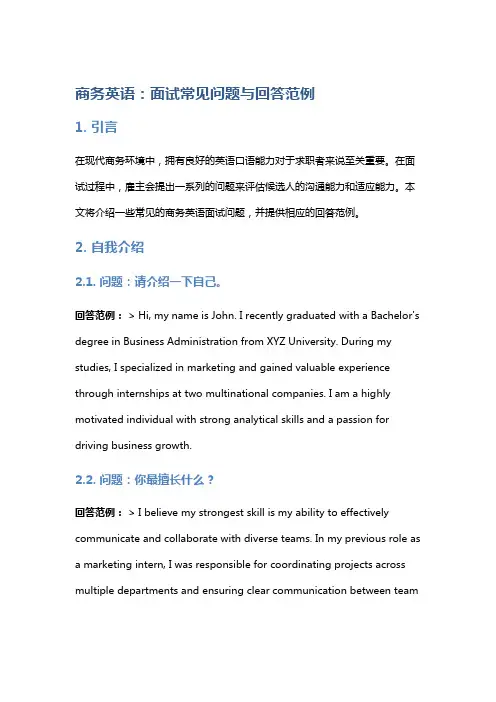
商务英语:面试常见问题与回答范例1. 引言在现代商务环境中,拥有良好的英语口语能力对于求职者来说至关重要。
在面试过程中,雇主会提出一系列的问题来评估候选人的沟通能力和适应能力。
本文将介绍一些常见的商务英语面试问题,并提供相应的回答范例。
2. 自我介绍2.1. 问题:请介绍一下自己。
回答范例: > Hi, my name is John. I recently graduated with a Bachelor's degree in Business Administration from XYZ University. During my studies, I specialized in marketing and gained valuable experience through internships at two multinational companies. I am a highly motivated individual with strong analytical skills and a passion for driving business growth.2.2. 问题:你最擅长什么?回答范例: > I believe my strongest skill is my ability to effectively communicate and collaborate with diverse teams. In my previous role as a marketing intern, I was responsible for coordinating projects across multiple departments and ensuring clear communication between teammembers. This allowed me to develop strong interpersonal skills and the ability to work efficiently in a team-based environment.3. 职业目标3.1. 问题:你对这个职位有什么期望?回答范例: > As someone who has always been interested in the retail industry, my goal is to build a successful career in marketing and contribute to the growth of a renowned company like yours. I am particularly excited about the opportunity to work on creative marketing campaigns and utilize my skills in data analysis to drive customer engagement and sales.3.2. 问题:你如何处理工作压力?回答范例: > I believe that effective time management and prioritization are key in managing work-related stress. In high-pressure situations, I find it helpful to break down tasks into smaller, more manageable steps, and set realistic deadlines for myself. Additionally, I make sure to maintain a healthy work-life balance by engaging in activities such as exercising, reading, and spending time with family and friends.4. 团队合作4.1. 问题:请分享一个团队合作的经历。
商务英语考试口语以下是商务英语考试口语的一些常见问题和回答,以及相应的中文翻译:问题1:请介绍一下你自己。
Answer: Good morning, my name is John Smith. I'm an experienced sales manager with a strong background in international business.翻译:早上好,我叫约翰·史密斯。
我是一名经验丰富的销售经理,有深厚的国际商务背景。
问题2:你为什么对这个职位感兴趣?Answer: I'm interested in this position because it aligns with my career goals and provides an opportunity to use my skills and experience in a global environment.翻译:我对这个职位感兴趣是因为它符合我的职业目标,并提供了一个在全球环境中使用我的技能和经验的机会。
问题3:你如何处理工作中的压力?Answer: When faced with pressure at work, I take a structured approach. I prioritize tasks, manage my time effectively, and seek support from my team when needed.翻译:面对工作中的压力时,我采取有条理的方法。
我优先处理任务,有效地管理时间,并在需要时寻求团队的支持。
问题4:你在团队合作中扮演什么角色?Answer: In a team, I typically play the role of a facilitator. I encourage open communication, help resolve conflicts, and ensure that everyone's contributions are recognized and valued.翻译:在团队中,我通常扮演协调者的角色。
商务英语口语的话题一、商务英语口语话题-产品介绍1.It is classic and simple model.But very hot sell in India.这是经典的款式,造型简单。
但是非常受印度客户的欢迎。
2.Could you send me the quotation of the models I asked just now?你能将我刚刚挑选的产品做份报价单发给我吗?3.Owing to its superior quality and reasonable price, our silk has met with a warm reception and quick sale in most European countries.我们的丝绸质量优良,价格公道,深受大多数欧洲国家的欢迎,非常畅销。
4.We feel that our product is the best kind in Asia and we can very well compete against Korea in price我们认为我们的产品在亚洲是最好的,在价格上完全可以与韩国竞争。
5.Our goods are greatly appreciated in other markets similar to your own.我们的产品在其他市场同在贵方市场一样受欢迎。
6.By virtue of this superior quality, this product is often sold out of stock in many areas我们的产品因其优秀的质量,在很多地区经常脱销。
7.Our products are superior in quality and moderate in price and are sure to be saleable in your market我们的产品质量优秀,价格适中,在贵方市场上一定很畅销。
商务英语口语考试话题1.商务英语口语考试话题篇一试题:出差前期准备:accommodation:book a hotel with adequate working facilities(such as fax machine, internet access, computers)transportation:choose a convenient/suitable means of transportati on费用:hotel bills, traveling expenses, public transportation fares, fax or telephone charges, client entertainment expenses考虑因素:cultural differences:different thought patterns;working style;w ays of decision-making;shopping habits;ways of seeing the world如何应对出差中的问题:become sensitive to the cultural differencebe open-mindedrespect native cultureconsider cultural taboosthe staff should acquaint with differences in language, laws and s ocial customsrelocate the employee to work abroad to experience different worki ng style2.商务英语口语考试话题篇二试题:招聘Recruiting内部招聘 internal promotion优点:have more motivational valueencourage employees to continue effortgive other employees anticipation of promotionreduce the orientation and training costmake good use of abundant human resources缺点:if not fair,it will lead to internal conflict内部招聘的具体做法:a selection test/well-designed interview/check record ofpast performance/appraisal外部招聘external recruitment优点:receive a source of new ideas/latest knowledgeavoid unfair selectingbe contributable to company's overall growth and success缺点:discourage moraleincrease training cost3.商务英语口语考试话题篇三Different Communication StylesThe way people communicate varies widely between, and even within, cultures. One aspect of communication style is language usage. Across cultures, some words and phrases are used in different ways. For examp le, even in countries that share the English language, the meaning of "yes" varies from "maybe, I"ll consider it" to "definitely so," with m any shades in between.Another major aspect of communication style is the degree of impor tance given to non-verbal communication. Non-verbal communication includes not only facial expressions and gestures; it also involves seatin g arrangements, personal distance, and sense of time. In addition, dif ferent norms regarding the appropriate degree of assertiveness in comm unicating can add to cultural misunderstandings. For instance, some wh ite Americans typically consider raised voices to be a sign that a fig ht has begun, while some Asian, African, Jewish and Italian Americans often feel that an increase in volume is a sign of an exciting convers ation among friends. Thus, some white Americans may react with greater alarm to a loud discussion than would members of some American ethnic or non-white racial groups.4.商务英语口语考试话题篇四Different Approaches to Completing TasksFrom culture to culture, there are different ways that people move toward completing tasks. Some reasons include different access to reso urces, different judgments of the rewards associated with task complet ion, different notions of time, and varied ideas about how relationshi p-building and task-oriented work should go together.When it comes to working together effectively on a task, cultures differ with respect to the importance placed on establishing relations hips early on in the collaboration. A case in point, Asian and Hispani c cultures tend to attach more value to developing relationships at th e beginning of a shared project and more emphasis on task completion t oward the end as compared with Americans. Americans tend to focus imme diately on the task at hand, and let relationships develop as they wor k on the task. This does not mean that people from any one of these cu ltural backgrounds are more or less committed to accomplishing the tas k, or value relationships more or less; it means they may pursue them differently.5.商务英语口语考试话题篇五Different Decision-Making StylesThe roles individuals play in decision-making vary widely from cul ture to culture. For example, in the U.S., decisions are frequently de legated - that is, an official assigns responsibility for a particular matter to a subordinate. In many Southern European and Latin American countries, there is a strong value placed on holding decision-making r esponsibilities oneself. When decisions are made by groups of people, majority rule is a common approach in the U.S.; in Asia consensus is the preferred mode. Be aware that individuals" expectations about their own roles in shaping a decision may be influenced by their cultural fr ame of reference.。
BEC初级:口试常见问题和常用表达BEC初级考试是商务英语能力证书中的一个等级,该等级主要考察考生的英语口语能力和商务应用能力。
在口试部分,考官会针对考生的个人信息、工作经验、职业规划等方面进行问题提问,同时也会要求考生使用英语表达某些情境和问题。
本文将介绍BEC初级口试中的常见问题和常用表达。
常见问题个人信息和学习经历1.Can you introduce yourself briefly?(请简要介绍一下你自己。
)2.Where are you from?(你是哪里人?)3.What’s your educational background?(你的教育背景是什么?)4.Have you learned any other languages?(你学习了其他语言吗?)5.Have you ever studied or worked abroad?(你曾经在国外学习或工作过吗?)工作经验1.Can you tell us about your work experience?(请介绍一下你的工作经验。
)2.What was your previous job?(你之前的工作是什么?)3.How long have you been working in your current position?(你目前所在职位的工作年限有多长?)4.What are some of the challenges you faced in your previous job?(你在之前的工作中遇到了一些什么挑战?)5.How did you handle conflicts with your colleagues or clients?(你如何处理与同事或客户之间的冲突?)职业规划1.What is your career goal?(你的职业目标是什么?)2.How do you plan to achieve your career goal?(你如何计划实现你的职业目标?)3.What skills do you think are important for your job?(你认为你的职位需要哪些重要技能?)4.What are your strengths and weaknesses?(你的优点和缺点是什么?)5.How do you handle stress in your work?(你如何应对工作压力?)常用表达自我介绍1.Hi, my name is [your name].(你好,我的名字是[your name].)2.I’m from [your city/country].(我来自[your city/country].)3.I’m [your age] years old.(我今年[your age]岁。
1.What do you think are suitable personalities for sales?你认为合适的销售个性?I think suitable personalities for sales should be outgoing, confident, honest, sociable and competitive.Because person who has these personalities,it is easy to communicate with customers, then make a good impression on them and at last sale the product to guests successfully.The most important personalities are patient and careful. You need to know more clearly about the requirements and doubts of customer in the process of sale product. And it can help you offer better choice for customer. They will be satisfied with you. It is good for you to sale more products and service to these customers.2. What are the steps to handle customers’ complaints in a proper manner?处理顾客抱怨Firstly, Listen attentively and show your concern to the customers’problem. Secondly,you need to keep calm and rational. Never argue with guest. Never try to explain yourself. Thirdly,try to apologize to the guest for their complain. Then solve the practical problem and show sympathy to them. You must to record this matter in case of take place again. Tell the guest the solution and the resolution time. Try your best to take action immediately . Don’t forget Follow-up visit ,we should make sure the problem is really solved. Finally, make sure the guest is satisfied with the result 3. What can convince you to buy when you do shopping?At first, the products’exquisite packing will catch my eyes. secondly the modern design of the product will appeal to me very much. Thirdly,the price should be reasonable. Then I will consider to buy the high quality product, because it is moredurable than normal product. The most important is the products’ practical value. If it is a multifunctional and useful product,it is worth to buy. Apart from these reason, I will take the shape and color into my consideration.Only the product can meet all of requirements,it is really worth to buy, I will be convinced to buy this product.4.Please introduce some useful communication skills with customersAt first, you should be a good listener to recognized the needs of customers. By chat with customers You can know about the the customers’personalities . T hen help the guest choose the product what he need, and introduce the advantages of the product and explain why this product is suitable for the customer. Find the breakthrough when I am selling, appeal to the customers’ interesting, which ultimately leads them to buy products. Show the respectful to the customer, and Say nice words to customers. In addition, I should be natural when communicate with customers,preform the appropriate body language.5.As a salesperson, how to make customers accept and trust you?We' need to think something on the the customers side and concerned about customers' demandTo be professional, Good manners and well-spokenoffer more and better services,they will feel comfortable and relievedYou must treat to the customer like a friend rather than just for get his moneyOnly if you can do that, you will make friend with customer.You must try your best to help the customer to solve problem which the customer faced, and understand them . Then the customer will trust you.Finally,we should be honest to them and show real self6.Please list at least 4 language techniques that can be used in advertising. 语言技术Firstly, cite figures to support the view point,the digital is concrete and highly persuasive. so using digital to introduce the pros and cons can relief the customers hesitation. Secondly,Set the suspense,a successful advertisement should attract the consumers attention,put up a question can inspire people to think,take advantage of the customers' curiosity and sold out the goods. Thirdly, describe the image by language, using the vivid language represent the shape,performance,feature of the product to stimulates the customers imagination. Fourthly,emphasized the produce again and again is also a good method,it devote to enforce the attention and memory,that is impressive7.In your opinion, what is a good slogan?An advertising slogan is to a brand what eyes are to a person. The slogan helps people understand the brand better by telling them what it wants to sell to its customers. Good slogans leave a message inside people,a good slogan must have these advantage: easy to understand,easy to remember,should draw people’s attention.persuasive and creative. If a slogan has these advantage, it can attract more people to buy the product which is using this slogan. And the purpose of the slogan is to increase the popularity of the brand or the product.8. Choose one marketing strategy from below, explain what it means and give at least one example of the strategy.病毒式营销是通过利用公众的积极性和人际网络,让营销信息像病毒一样传播和扩散,营销信息被快速复制传向数以万计、数以百万计的受众。
In this part each candidate’s task is to choose one topic from a set of three, and to talk about it for one minute. Candidates have one minute in which to prepare and should use this time to make brief notes. The other candidate listens to the talk and is invited to ask one or two questions at the end. Candidates may make notes while listening to their partner. Each candidate is given a different set of three tasks from which to choose.General procedureA choice of three different topicsOne minute preparation while making notesA/B starts with the other listening---one minuteQuestion asked1. Customer relation: the importance of offering incentives to customersOffering incentives to customers can help you to strengthen your customer base and enhance customer loyalty. If you offer incentives such as vouchers, complementary tickets, miles, gifts in the promotion or sales, you will attractive more customers and get them buy your products or services. At the same time the image of your company will be improved and your brands are more likely to be known by customers.2. Product promotion: how to ensure that products are promoted effectively at international trade fairsYou should send a professional team of experts to arrange the promotion at the trade fair. They must be familiar with the products you want to promote at the fair. Meanwhile they must be good at dealing with clients especially foreign clients.You should use advanced technology to display your products at the fair. Necessary equipments such as DVD, overhead projector, high-definition screen can help you demonstrate the quality, function and specification of your products.You should design your show room and stand carefully to attract more customers. Your stand should be put up at an obvious place so that every customer can get an easy access to your products.3. How to reduce labor turnover ratesIn order to reduce labor turnover rates we must take the following effective measures:Set up a clear staff appraisal process to make sure that the performance of every staff can be evaluated openly and honestly and their promotion is based on their contribution to the company. Thus no one will complaint about unfair promotion which once forced some of your staff to leave their jobs.If permits enhance the staff benefits including their base pay annual bonus and other benefits. An incentive system should also be necessary to encourage the staff to work with the company longer.Improve the work environment of your company or factory. Try to foster a spirit of mutual help among your staff and let them understand that the company or factory is far more than just a workplace. It’s a family where all members are supported and valued.4. Career development:the importance of being willing to acquire new skills throughout your careerWith the unceasing development of science and technology the workplace is now undertaking profound changes. The way you do your work and the equipment you use in your work will definitely change or upgrade in the future, which means you have to learn new skills to deal with these changes. Remember: you are never too old to learn. New skills will make you keep up with the latest technology and help develop yourself throughout your work life.5. International sales: how to research foreign markets effectivelyYou should notice the difference between foreign and domestic market and set your target according to specific situation of foreign market. For example: given the different state of living standard the purchasing power of your target market may be higher or lower than the domestic market. If you ignore the difference you are likely to make mistakes in products’ pricing in foreign market.You should ensure that your research team is excellent at carrying out research in a foreign country. That means every member of the team should mater the native language and be familiar with the specific culture of the target market.6. Production management: how to implement an effective just-in-time system What is a JIT production system?JIT is an approach to achieving excellence in a manufacturing company based on the continuing elimination of waste (waste being considered as those things that do not add value to the product).A repetitive production system in which both the movement of goods during production, and deliveries from suppliers, are carefully timed so that at each step of the process, the next (usually small) batch arrives for processing just as needed.The logic behind JIT: Nothing will be produced until it is needed.7. Travel:the importance of being able to speak foreign languages in international business8. Marketing: how to assess whether there is a market for a new productYou should carry out a research on the customer demands to see if there is a read need in the market for your new product. The feedback or result will help you to decide whether to launch the new product on the market.You should pay special attention to your competitors. Detect whether they are going to launch their new product onto the market. if the answer if yes that probably means there is a demand in the market for some new product. Then be quick and put on your rival product to coincide with them.9. Human resources: how to use staff appraisal schemesYou should see to it that the staff appraisal schemes be a chance for management and employees to come together and exchange ideas, set joint targets and improve the way decisions are reached.The scheme should have a clear appeal process and any negative feedback should be accompanied by evidence such as dates, times and outcomes. Most importantly ratings should reflect measurable element of the job requirements.10. Advertising: the importance of television and cinema advertisementIn fact television and cinema advertising both function as a kind of media which tells or even guides people to buy products or services. With the development of the telecommunication television has become the most important carrier of advertisement and as a result of that TV advertising has the largest amount of audience all over the world. They have penetrated into people’s daily life and persuaded them to buy whenever they turn on them. On the other hand the popularity of the movie make every audience be under the influence of cinema advertising at the beginning and end of the movie.11. Staff management: how to ensure effective lines of communication between the workforce and managementAs the leader of the company you should open up a channel for the workforce and management to communicate directly. For example you can hold a monthly meeting within the company, which is attended by both the reps from workforce and management. They are allowed to talk with each other openly and freely to exchange views and opinions. They can also set common objectives.You should achieve this effectiveness by making use of up-to-date technologies. For example you can set up a forum on the intranet of your company so that every member can air and exchange their views on the forum. In this way a effective line of communication will be set up.You should set up an incentive system to make your staff talk with their line managers.12. Finance: how to ensure accurate cashflow forecastsyou should establish a monitor system in the first place to detect any possible cashflow gap which will occur during your production and operation. This system can calculate the balance between your income and expenditure on a daily base. And should there be any sign of cashflow problems the system will warn your staff to do something about it before hand.In order to achieve the accuracy you must set up a report system which demands every manager report the current financial status of his or her departments. The information will be collected everyday for you to take consideration.13. International sales:how to decide which sales incentives to offer a new foreign customer (本题做为思考题,请大家自行考虑一下。